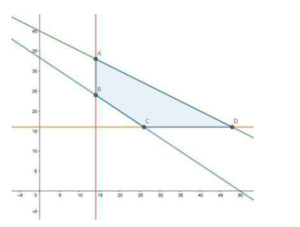Let ![]() and
and ![]() be number of
be number of ![]() and
and ![]() products.
products.
![]() According to the question.
According to the question.
![]()
Maximize ![]()
The feasible region determined by ![]() is given by
is given by

The corner points of feasible region are ![]() .The value of
.The value of ![]() at corner points are
at corner points are
![Rendered by QuickLaTeX.com \[\begin{tabular}{|l|l|l|} \hline Corner Point & $\mathrm{Z}=20 \mathrm{x}+30 \mathrm{y}$ & \\ \hline $\mathrm{A}(14,33)$ & 1270 & \\ \hline $\mathrm{B}(14,24)$ & 1000 & \\ \hline $\mathrm{C}(26,16)$ & 1000 & \\ \hline $\mathrm{D}(48,16)$ & 1440 & \\ \hline \end{tabular}\]](https://www.learnatnoon.com/s/wp-content/ql-cache/quicklatex.com-40949660d58717e28ecd78d56ee91784_l3.png)
The maximum value of ![]() is 1440 at point
is 1440 at point ![]() .
.
Hence, the manufacturer should manufacture 48 A products and ![]() products to maximize their profit of Rs. 1440 .
products to maximize their profit of Rs. 1440 .
